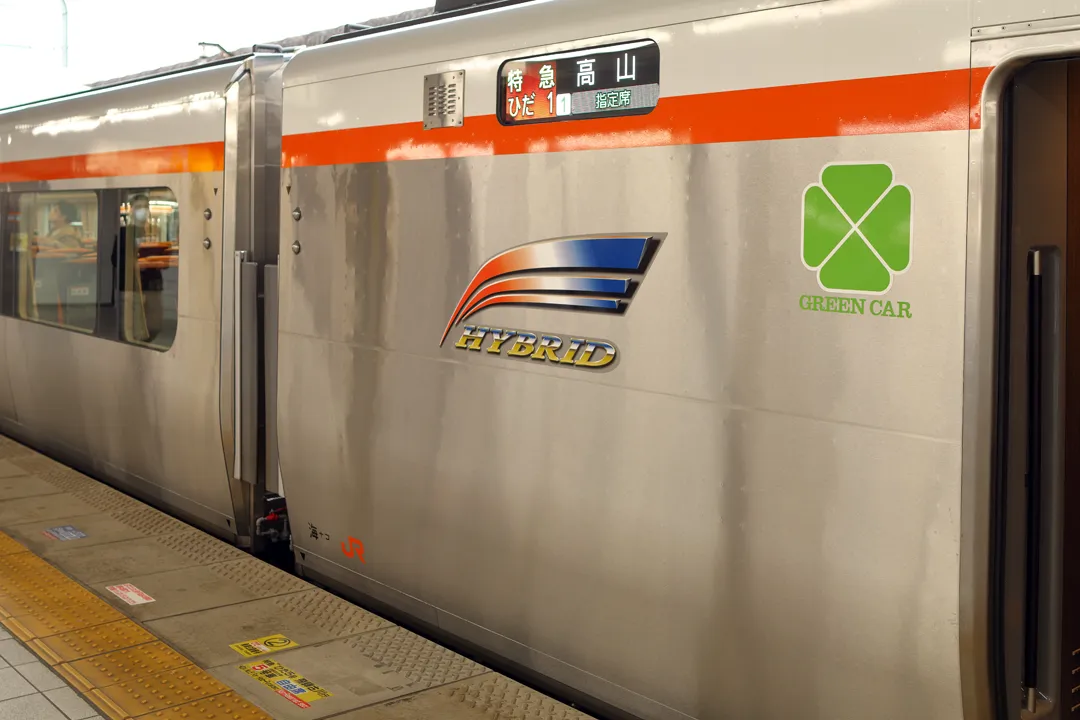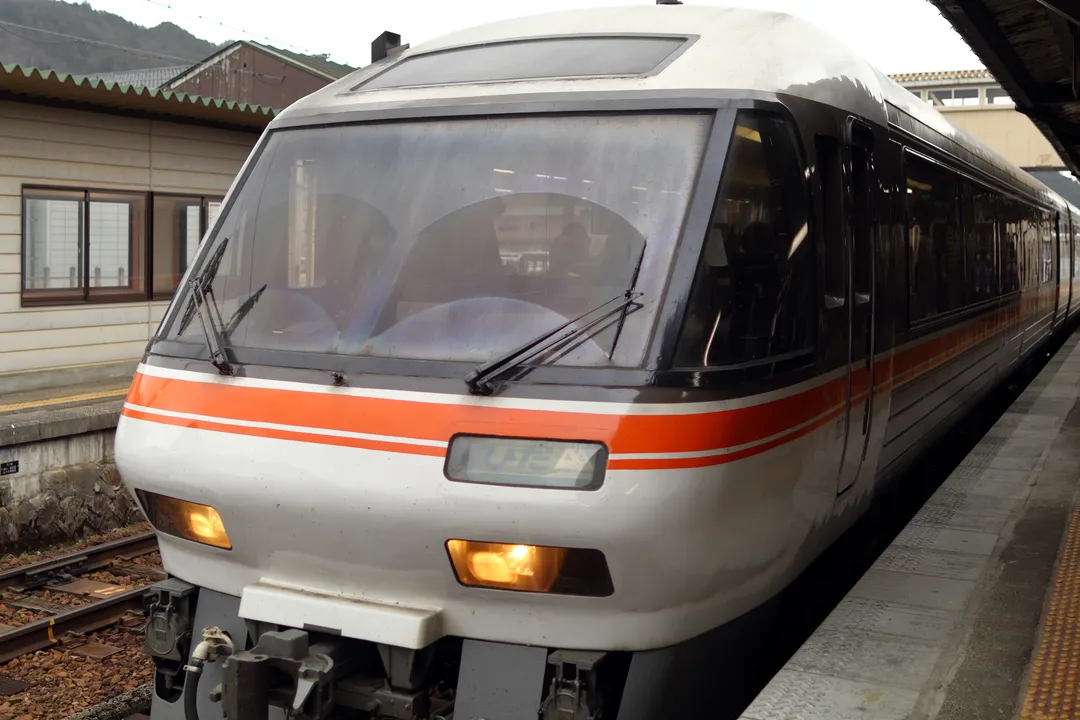Central Japan, or the Chūbu region, is divided into two sides: in the north, the Sea of Japan coast from Fukui to Niigata, and in the south, the more densely populated Pacific coast from Nagoya to the Izu Peninsula in Shizuoka. In between them lies the formidable 3,000 m peaks of the Japanese Alps. While the fastest way to travel from one coast to the other is to take a detour via Tsuruga, we opted for the more scenic route through the center, with a stop at the historic town of Hida-Furukawa in the heart of the mountain range.
Early in the morning, we checked out of the JR Gate Tower Hotel in Nagoya and went to the adjacent Nagoya Station. Since it was a weekend, the rush hour crowds were manageable and we had no difficulty getting through with luggage.

We went to the platform for the Hida limited express bound for Takayama, a major tourist destination in the Japanese Alps but a few stations short of Hida-Furukawa. The train used on this route is the HC85 series, one of the newest available models.

This is a hybrid train with both diesel engines and batteries, conceptually like a scaled-up version of the more commonly seen hybrid cars and buses. Japan is a leader in adopting hybrid propulsion on railways; the technology was first introduced in 2007 and is now in regular operation in several places around the country.

Two and a half hours later, we arrived at Takayama. Nearly all passengers left the station there, but we instead transferred to a two-car local train, along with no more than ten others. Then, it was only a 15-minute ride to Hida-Furukawa, three stations away.

While Hida-Furukawa Station only sees around 400 passengers per day, the ticket office is still staffed and there are a dozen or so coin lockers installed at the tourist information center next door. Since we had arrived on the first train of the day, we easily had our pick of available lockers. After checking the map of tourist attractions, we set off toward the town center, just a few minutes’ walk away.

As expected of a small town in the Japanese countryside, the streets were virtually empty and most of the businesses were shuttered. Perhaps during summer, Hida-Furukawa would have more visitors and a livelier atmosphere, but on this overcast winter day, we more or less had the entire town to ourselves.

A few blocks from the station, we came upon the representative scenery of Hida-Furukawa — white-walled traditional buildings alongside a canal. The canals were originally built 400 years ago for irrigation and fire prevention, but they eventually became polluted as a result of industrialization and were not cleaned up until the 1990s. Today, the water is clean enough that carp can live there during the warmer months. However, all carp are removed for safekeeping between November and April because it is too cold, so we were unable to see them.

Further down the street, we passed by the Shinshū Temple. It was founded over 500 years ago, in 1502, and then moved to its current location in 1542, but was destroyed by fire in 1904 and finally reconstructed in 1912. Usually, local temples are used by the nearby residents to pray, but we saw nobody there, not even any staff.

The main building has an impressive scale, considering the modest size of the town, and is well-maintained.

Past the temple, we crossed a bridge over a small river, just upstream of where it joins the larger Miya River that bisects the town.

At the confluence of the two rivers, there is a waterfront park, where we spent some time admiring the view of the water and mountains. Far away from the main road, it was very quiet and peaceful there, but still cold even though the clouds were parting.

A pedestrian bridge links the park with the other side of the larger river. We went to the middle to see the view, but we didn’t cross all the way because the western part of the town, consisting of newer houses and light industry, has little of interest.

Unlike in Shikoku, the row of cherry trees in the park had yet to flower due to the higher altitude and colder climate.

We turned around and headed back to eat lunch. A major disadvantage of visiting small towns is the difficulty of finding restaurants. For almost an hour, we wandered fruitlessly in search of one that looked good, although we got distracted by the scenery a few times.

Eventually, we noticed the Matsuri restaurant, a small and unassuming concrete building with a rather unfitting architectural style. The banner outside advertised Hida beef, which is a type of wagyu beef locally produced in Gifu Prefecture. We quickly decided to enter as we were running out of options.

Inside, there was only one other customer, so we were seated in short order. The beef was expensive (in excess of 4,000 yen for a simple lunch set with rice and miso soup), but still cheaper than a similar meal in Tokyo or other major cities. That said, its quality was unmatched and it remains the best-tasting beef that we’ve eaten anywhere, and well worth the time spent searching for it.


Even though the meal was immensely satisfying, we sought dessert afterward and returned to a cheesecake shop that we had passed earlier. At first, it was not obvious whether it was open, but I could read Japanese sufficiently to understand the small sign on the door instructing customers to enter and wait inside.

The owner heard the doorbell and came to lead us to be seated. The interior, with only a handful of seats arranged in a small room, seemed more like a residence than a business. No other customers were there, although one came later while we were eating.

We sat next to the window, looking out to a traditional garden in the courtyard behind the building, not visible from the street.

The menu contained only several types of tea and coffee, and a few desserts. All food and drinks had the same price of 750 yen, which is quite expensive for one slice of cheesecake, but much like the beef, it was of outstanding quality. The presentation was also worthy of any high-end restaurant in a large city.


Ritz was very happy with everything and asked the owner for a photo before we left.

After dessert, we had about one hour left before the train to Toyama, so we had a chance to check out the souvenir shop across the street. When we passed it earlier, we were drawn to the cat designs displayed outside, but it had been closed. As it was open now, we found and bought matching cat shirts there.

The owner also had many other animal designs that he had drawn himself, and when he learned that it was our honeymoon, he kindly gave us postcards for free. Ritz asked him for a photo as well.

Then, it was time to start going back toward the station. On the way there, I noticed this contrasting scene with a curious sort of symmetry.

We took a slightly different route back than we had come from in the morning, and we saw some more restaurants on a side street leading to the station. However, such establishments are generally drinking places catering to locals and wouldn’t have been open for lunch. It’s hard to imagine any kind of nightlife in Hida-Furukawa. What would it be like here after dark?

Back at the station, we enjoyed one last view of the town from the pedestrian overpass before retrieving our luggage.

From there, we could also see the layout of the station. Even though there is only one train per hour in each direction, there are three platforms, remnants of an era before widespread private ownership of cars.

The train that would take us onward to Toyama was the old type, which was already in the process of being phased out by JR Central. As a matter of fact, this was the final week of its operations on this line. Its exterior was visibly dirty.

On the other hand, passenger accomodations in this old train were actually better than in its replacement. It had wider seats in a 2+1 layout and a large viewable window in the front. We were unable to book the seats in the first row because they had already been booked by someone else, but as tired as we were after another long day of walking, it was fine to just sit and rest for the entire ride.

